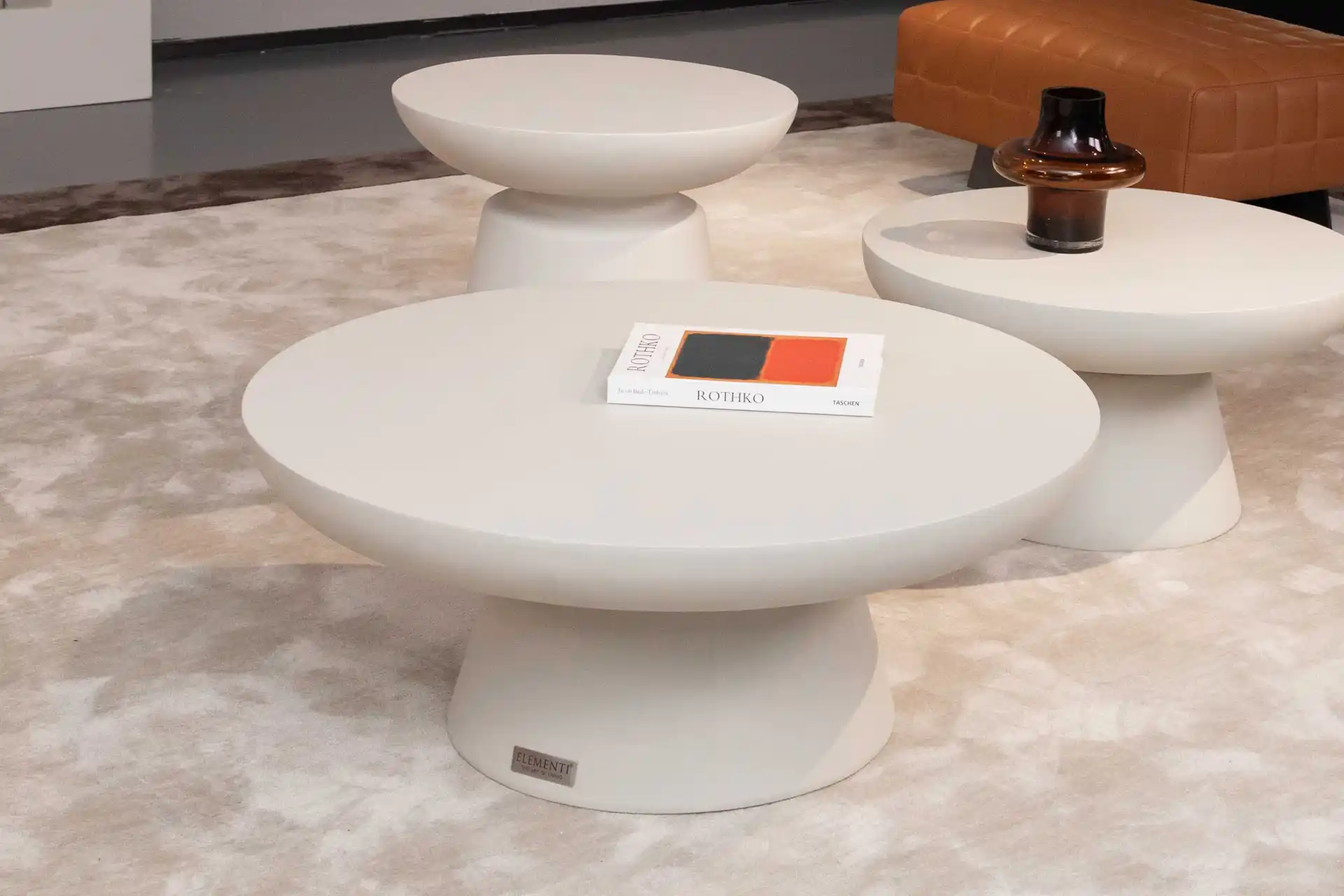Beton is no longer just a building material, but a calm, powerful presence in the room – as a table, bench or sculptural object.
The fascination of Beton often lies in its restraint. It appears calm, grounded and honest. When Beton enters the living space in the form of furniture, a technical material becomes a design language that shapes the atmosphere: quietly, but clearly noticeable.
Whether as a coffee table, side table, dining table or seating furniture – concrete furniture strengthens the structure of a room without pushing itself to the fore. They create a focus, provide calm and bring a unique depth to the interior.
1 The special radiance of concrete furniture
At first glance, Beton conveys strength and durability – but there is another layer to furniture: an unexpected softness. The surfaces can be silky smooth or gently textured, the edges softly tapered, the colors subtle and warm.
In contrast to many eye-catching materials, Beton does not work with volume, but with presence. It acts as a calm pole in the room, holding together and balancing other materials – wood, fabric, metal.
- not playful, but clear and focused
- Not loud, but permanently present
- not decorative, but honest and pure
2 Form and line: Beton as sculptural furniture
One of the greatest advantages of Beton in furniture design is its freedom of form. Clear geometries as well as soft, organic silhouettes can be realized through casting and moulding. This means that concrete furniture can be used specifically as “small pieces of architecture” in a room.
You often encounter:
- round or oval coffee tables with a very fine edge,
- cubic side tables with clear lines,
- monolithic dining tables that look as if they were made from a single piece,
- sculptural plinths that are both furniture and object.
A concrete table is not only perceived as a usable surface, but also as a calm focal point that gives the room structure.
3 Color and texture: the quiet diversity of Beton
Anyone who only thinks of dark gray when it comes to Beton underestimates its range. Modern concrete furniture ranges between soft, warm and light tones that blend effortlessly into different interior design concepts.
- Light gray & greige: very understated, ideal for minimalist rooms.
- Sand and beige tones: look warm and homely, especially in combination with wood and textiles.
- Dark charcoal tones: make a clear statement without appearing overloaded.
Then there are the different surfaces:
- silk-matt polished – calm, clear, elegant,
- gently porous – with visible “skin” and a natural appearance,
- slightly structured – for more depth and tactile excitement.
4 How concrete furniture changes a room
4.1 In the living room: a quiet centerpiece
A coffee table or side table made of Beton acts like an anchor in the room. The soft upholstered landscape is given a solid counterweight that provides clarity. Concrete furniture helps to visually bundle the seating area, especially in open-plan living and dining areas.
4.2 On the terrace and balcony: material that speaks to its surroundings
Outside, Beton harmonizes particularly well with plants, wooden decking, natural stone and textiles. A concrete table or bench blends almost naturally into its surroundings – like a piece of landscape architecture in miniature.
4.3 Reading corner & home office: small spaces with a big impact
A small concrete side table next to the armchair, a compact beton table as a workstation – a single piece is often enough to give a corner of a room weight, character and calm. Concrete furniture functions here like a quiet frame for everyday rituals.
5 Craftsmanship and individuality: why no two pieces are the same
Behind every piece of concrete furniture is a handcrafted process: mold making, mixing, casting, demolding, sanding and finishing. Small air pockets, fine shading and minimal differences in the surface are all part of the process – they make each piece unique.
This “imperfection” is intentional: it gives the furniture character and prevents it from appearing sterile. Beton lives with you – and is allowed to develop its own patina over the years.
6 More than just robust: the true value of concrete furniture
Anyone who chooses concrete furniture is not just buying “something that will last”. The real value lies in the effect it has on the room: in the calmness it radiates, in the clarity of the shapes, in the depth of the material.
Concrete furniture is not a loud eye-catcher. They are more like a good foundation: you may not always consciously notice them – but the room wouldn’t be the same without them.
Perhaps it is precisely this mixture of calm, strength and restraint that makes concrete furniture so special. It does not impose itself – it leaves space for people, for light, for the life that takes place around it.
Anyone who values honest materials, clear lines and a timeless atmosphere will find concrete furniture to be a quiet but extremely strong ally in the room.
7 Common misconceptions about concrete furniture – and the real facts
Is concrete furniture a new invention?
No – the idea is over 100 years old. In fact,
He used it to make several pieces of furniture, including a cabinet for a gramophone. Edison claimed that Beton was more durable, more economical and just as aesthetically pleasing as wood – and could be color-matched to look like any wood.
His idea didn’t catch on at the time, but looking back, he was right: Beton has enormous potential as a furniture material.
Is all concrete furniture extremely heavy?
Not necessarily. Although traditional cast concrete furniture is heavy, this can actually be an advantage outdoors – it remains stable even in strong winds.
For interiors, many designers and manufacturers now use significantly lighter concrete mixtures, often inspired by Edison’s earlier experiments. In addition, fibers and reinforcements are used that enable thinner wall thicknesses.
- Large furniture is usually cast in several segments to facilitate transportation and assembly.
- Some models are fitted with discreet castors or furniture glides to make them easier to move.
You can find more background information on the properties and advantages of the material in our guide “What are the advantages of Beton?” .
Is Beton seating uncomfortable?
A common misconception. Beton is no more uncomfortable to sit on than materials such as
Modern designers often create their seating furniture with ergonomic curves so that the shape supports the body comfortably – even without upholstery.
Does concrete furniture match my interior at all?
Yes – Beton is surprisingly versatile. It can take on any shape, texture and almost any color. That’s why it harmonizes with classic, modern, minimalist or rustic living styles.
Whether warm beige, soft gray, elegant round shapes or clear lines – concrete furniture can blend in seamlessly or deliberately set accents.











